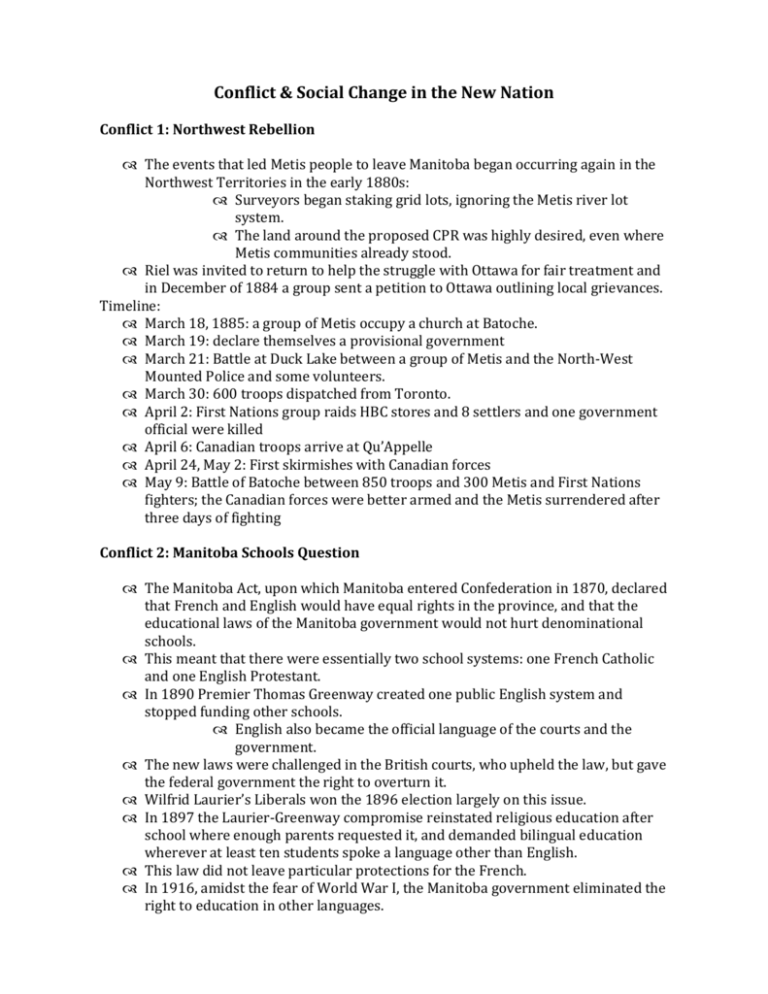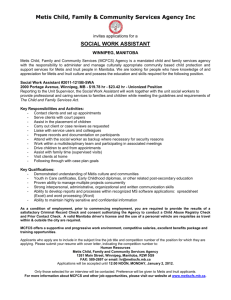Conflict & Social Change in the New Nation
advertisement

Conflict & Social Change in the New Nation Conflict 1: Northwest Rebellion The events that led Metis people to leave Manitoba began occurring again in the Northwest Territories in the early 1880s: Surveyors began staking grid lots, ignoring the Metis river lot system. The land around the proposed CPR was highly desired, even where Metis communities already stood. Riel was invited to return to help the struggle with Ottawa for fair treatment and in December of 1884 a group sent a petition to Ottawa outlining local grievances. Timeline: March 18, 1885: a group of Metis occupy a church at Batoche. March 19: declare themselves a provisional government March 21: Battle at Duck Lake between a group of Metis and the North-West Mounted Police and some volunteers. March 30: 600 troops dispatched from Toronto. April 2: First Nations group raids HBC stores and 8 settlers and one government official were killed April 6: Canadian troops arrive at Qu’Appelle April 24, May 2: First skirmishes with Canadian forces May 9: Battle of Batoche between 850 troops and 300 Metis and First Nations fighters; the Canadian forces were better armed and the Metis surrendered after three days of fighting Conflict 2: Manitoba Schools Question The Manitoba Act, upon which Manitoba entered Confederation in 1870, declared that French and English would have equal rights in the province, and that the educational laws of the Manitoba government would not hurt denominational schools. This meant that there were essentially two school systems: one French Catholic and one English Protestant. In 1890 Premier Thomas Greenway created one public English system and stopped funding other schools. English also became the official language of the courts and the government. The new laws were challenged in the British courts, who upheld the law, but gave the federal government the right to overturn it. Wilfrid Laurier’s Liberals won the 1896 election largely on this issue. In 1897 the Laurier-Greenway compromise reinstated religious education after school where enough parents requested it, and demanded bilingual education wherever at least ten students spoke a language other than English. This law did not leave particular protections for the French. In 1916, amidst the fear of World War I, the Manitoba government eliminated the right to education in other languages. Conflict 3: Sifton’s Immigration Policy In 1896, Prime Minister Wilfrid Laurier appointed Clifford Sifton as the minister of the Interior. Sifton transformed immigration by: Making it easier for settlers to acquire free or relatively cheap land. Creating a massive advertising campaign, calling the Canadian prairies “the Last Best West” Advertising in Britain and the United States, but also in Eastern Europe, because their similar climate meant they might succeed best on the Canadian prairies Immigration increased and became more exclusive: Sifton’s policy sought farmers and excluded town folk (shop keepers, artisans, and labourers), because he believed they would create slums and contribute to unemployment. Many Canadians opposed Sifton because he was diluting the British nature of Canada. Many Quebec residents opposed Sifton because his policies would exclude them from claiming land in the West. Conflict 4: Women’s Suffrage Early movements: In Manitoba, Icelandic women were demanding the vote as early as the 1870s. In Ontario, a formal Suffrage Association was established in the 1870s. The Women’s Christian Temperance Union fought alongside Suffrage organizations. In the 1880s and 90s, several provinces granted the vote to widows and unmarried women who owned property. Nellie McClung became the dominant figure in the prairie campaign, and staged an important mock parliament at the Walker Theatre in Winnipeg in January of 1914. In January of 1916, women gained voting rights in Manitoba. Other provinces gained rights as follows: Saskatchewan in March 1916; Alberta in April 1916 BC and Ontario in April 1917 Quebec in 1940! Women gained the federal vote in May 1918; the federal conversation revolved around their contributions to WWI. Conflict 5: Conscription Crisis Military enlistment for WWI started strong. From the beginning of WWI, propaganda flooded newspapers, posters, and government speeches, encouraging enlistment in the military and support for the war effort. A high number of casualties and letters about the horrible conditions meant voluntary enrolment didn’t meet the needs of the war. In May 1917, Prime Minister Robert Borden announced plans to pass the Military Service Act, which included conscription. French Canadians overwhelmingly opposed conscription. Farmers and religious groups also opposed conscription. Conscientious objectors were persecuted and jailed. The Military Service Act became law in August 1917. To prevent voter backlash, Borden’s Conservatives passed the Wartime Elections Act in December which granted the vote to wives and mothers of serving soldiers, and took the vote away from conscientious objectors and enemy aliens. Conflict 6: Winnipeg General Strike On May 15, 1919, members of the Building and Metal Trade Councils in Winnipeg went on strike demanding: 48 hour work week A minimum wage The right to collectively bargain for better working conditions. 27,000 workers in all sectors joined them, shutting down most city services mail, telephone, streetcars, police & fire departments). The strike was opposed by the Citizens’ Committee of 1000, which included wealthy businesspeople, professionals, and government leaders. The Committee rejected demands and blamed the strike on communist immigrants. The federal government passed legislation permitting the deportation of foreigners suspected of revolt. The strike culminated in violence on June 21st, and two strikers were killed that day as police fired into the crowd. The strike was called to an end on June 26th. Instructions: Complete all six row of the chart below, describing the sides/perspectives in each of the six conflicts above. Brainstorming current conflicts that have some of the same characteristics. The Century-Old Conflict 1 2 3 4 5 6 Conflict Today









